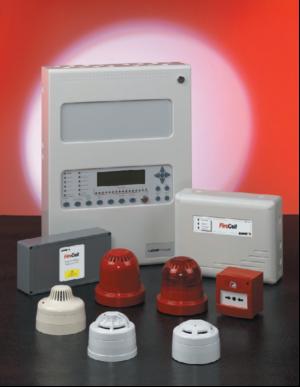Ray Puttock explains how wireless fire detection systems
can help alleviate the need to penetrate the building
fabric, which he says, in turn, reduces the risk, cost, time
and hassle of dealing with asbestos
The HSE eRay Puttock explains how wireless fire detection systems
can help alleviate the need to penetrate the building
fabric, which he says, in turn, reduces the risk, cost, time
and hassle of dealing with asbestos
The HSE estimates that up to
500,000 commercial, industrial
and public buildings built before
the year 2000, such as historic buildings,
are likely to contain asbestos in some
form. This means that anyone aiming to
improve the safety of the building by
installing a wired fire detection system,
which requires chasing cables into the
fabric of a building, themselves faces the
risk of exposing the asbestos.
Widely used in the 1960s, facilities and
building managers are now faced with
asbestos as a challenge when refurbishing
existing buildings from this era. This is an
ironic challenge - in making the building
safer, an installer faces the risk associated
with the potential piercing or removal of
asbestos within the building fabric.
Asbestos is a known risk. According to the
HSE it has caused around 4000 deaths each
year. Asbestos is found in several forms
within the building fabric and a fire system
installer is likely to come across one or more
of these when working on an older building,
depending on the age and extent of the
system required. There are three main types
of asbestos still found in buildings - blue
asbestos (crocidolite), brown asbestos
(amosite) and white asbestos (chrysotile),
blue and brown being the most hazardous.
Asbestos can be found in a number of
building materials such as asbestos insulating
board (AIB) and perforated AIB ceiling tiles.
If work is being carried out to install a
wired fire detection system within an
older building the consultant engineer
and installer will both know all too well
the need to survey for the presence of
asbestos. When work commences great
care and a planned course of action is
required to prevent dust, instead keeping
the asbestos wet and ensuring the work
area is clear of unnecessary human
presence. However, advances in fire
detection and protection technology
actually mean there is a way to avoid the
need to pierce or penetrate the building
fabric at all - the risk, cost and the time
consuming nature of asbestos removal is
itself removed.
Go wireless
A radio-based, wireless fire detection
system does not require the same building
fabric penetration in order to install it. In
fact a wire-free system is the ideal retrofit
solution in any number of applications,
because it significantly reduces the time,
cost and disruption of installation. For
facilities managers, building services
engineers, building owners and installers
it is important to consider the need for
legislative compliance when selecting a
wireless solution. EN54 part 25 covers the
standards expected of radio controlled fire
safety equipment. The FireCell from EMS
is one system that has been developed to
exceed these requirements, providing the
ideal alternative for retrofit installations.
A fire system controlled wirelessly uses
bi-directional radio links instead of
electrical cabling to communicate across a
whole building or even multiple
buildings. Decision makers should look
out for products that offer full analogue
addressable fire detection that
incorporates industry-standard sensors.
Individual devices should be powered by
separate battery packs to ensure each
device communicates with the controllers
using secure, fully compliant, dual
frequency signalling.
With no need for cabling whatsoever,
there is no need to drill into the building
fabric. This not only removes the risk for
the installer, but also reduces the
installation time and cost of fire-rated
cabling.
Although new buildings are designed
and constructed without the use of
asbestos, the risk of disturbing asbestos in
buildings pre-1999 is still significant.
Selecting a wireless approach not only
removes the risk associated with asbestos
for installers and building users who may
be present during installation, but also
reduces many other challenges such as
downtime, high costs and damage to a
building's overall look and finish.
For further information on EMS Radio
Fire & Security's FireCell System visit:
www.emsgroup.co.uk
Ray Puttock works for EMS Radio Fire &
Security.


